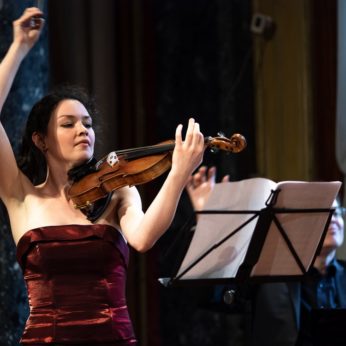Composer: Ludwig van Beethoven (b. 1770 - d. 1827)
Performance date: 29/06/2019
Venue: Bantry Library
Composition Year: 1802
Duration: 00:26:38
Recording Engineer: Ciaran Cullen, RTÉ
Instrumentation: 2vn, va, vc
Instrumentation Category:Duo
Artists:
Izabella Simon -
[piano]
Mairead Hickey -
[violin]

Ludwig van Beethoven [1770-1827]
Violin Sonata No.6 in A major Op.30/1 [1802]
1. Allegro
2. Adagio
3. Allegretto con variazioni
A composer’s success in his lifetime often depends on his business acumen. Mozart spent much of his life searching for the Eldorado of a court appointment, which involved long, humiliating sessions in the ante-rooms of the rich and powerful. Towards the end of his life Mozart was managing to find a way to juggle his various sources of income, a court appointment, different opera houses, other small commissions, music publishers, an English concert promoter and a Kapellmeister posting. Mozart’s problem was a familiar one to many of us, he always lived beyond his means and his fees were spent before they were earned. Beethoven managed his affairs better; he did not have an expensive wife and family and he was far less concerned with the niceties of fashionable dress. He not only had a good business sense but he also had a brilliant knack of attracting the support of rich aristocratic patrons. And around the time of the Op.30 sonatas he had enlisted the organisational and entrepreneurial abilities of his brother Carl, who managed to extract vastly increased prices from Beethoven’s publishers. Beethoven had let the First Symphony and the Septet go for 20 ducats apiece whereas Carl got nearly 130 ducats for the three Op.30 sonatas.
These sonatas were composed in a burst of energy in the spring of 1802, the year of the famous Heiligenstadt Testament, the despairing document he wrote when he realised his deafness was incurable and he regarded an early death as inevitable. However there is no trace of this angst in this delightful A major Sonata. The two main themes in the first movement are models of gentle lyricism with a distinctive bass semi-quaver figure introduced by the piano in the first bar acting as a talisman throughout the movement. The second subject is the more graceful, but it is the first subject with its unpredictable pauses and abrupt phrases that are typical of Beethoven. The slow movement is a ternary form Adagio, a gentle song of love enfolding moments of revelatory tenderness. The original Presto finale was replaced with the colourful set of variations as Beethoven felt the original was too brilliant for this sonata. A year later the original finale came in useful, when Beethoven wanted to write a new sonata for the violin virtuoso George Bridgetower. This gave him the unusual problem of writing a sonata to fit a pre-existing last movement with, it must be said, spectacular results. Returning to our A major sonata, we have an easy-going theme followed by six well-contrasted variations with the fifth in A minor, while the sixth somehow extends itself into a separate finale of its own.
Francis Humphrys
Copyright © 2025 West Cork Music. All rights reserved.
Designed and developed by Matrix Internet